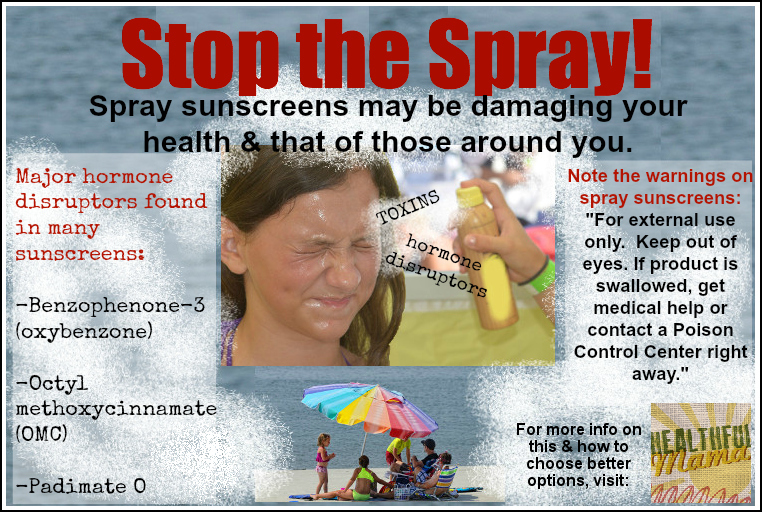Crashing waves. Sand warming your toes. Bright rays of the joyful sun. Vibrant laughter floating on the seabreeze, as well as….PSHhhhhhhhhhhhhhhhhhhsssssssssssssssst! Oxybenzone entering your lungs…
Without fail, each summer, beaches up and down the coasts (and playgrounds, sporting events, picnic areas, and campsites across the country) are infiltrated with families who insist upon using spray sunscreen. The invention of sunscreen in a can revolutionized the sunscreen application process. Parents of wriggly, excited children everywhere found a quick, simple way to protect their children’s skin. But did they?
[pinit]
 Please pin this and spread the word! [pinit]
Please pin this and spread the word! [pinit]
FACT: the active ingredients in most sunscreens are known hormone disruptors.
What you put on your skin DOES enter the body. The skin is your largest organ, after all! The three major hormone disruptors found in sunscreens (among a host of “lesser” disruptors), Benzophenone-3 (oxybenzone), Octyl methoxycinnamate (OMC), and Padimate O, can enter the bloodstream and organs, causing hormone disruption, thyroid effects, and/or immune effects. If you’re unsure of why you should be concerned about hormone disruption, read my post on epigenetics.
FACT: sunscreen ingredients were never meant to be inhaled.
This is seemingly common sense, yet parents spraying sunscreen in their children’s faces clearly haven’t heard the news. The instructions for spray sunscreen explicitly state to spray on one’s hands before application, so the industry is admitting on their packaging that spraying this substance is unsafe. Even mineral or natural sunscreen ingredients aren’t supposed to end up in your lungs.
FACT: instructions on bottles of spray sunscreen explicitly warn against getting the product in one’s eyes or ingesting it.
If either occurs, medical help or the Poison Control Center should be contacted (it says so on the package). A general rule of thumb when dealing with ingredients is: if it’s unsafe to get in your mouth or eyes, you probably don’t want it in the air, either.
FACT: not all sunscreen prevents skin cancer.
Only broad-spectrum sunscreen protects against both UVA & UVB rays. Some sunscreens may keep you from turning into a lobster, but still allow damage to skin cells by only blocking UVB rays.
FACT: there is evidence that ingredients in sunscreens may CAUSE skin cancer.
I talked about this a bit in my post, Don’t Fear the Sun. Toxic ingredients in many sunscreens are actually carcinogenic. Slather them over your body and apply heat? That’s a recipe for later health issues.
FACT: the best way to avoid harm from sun exposure is to stay out of the sun during peak hours & wear clothing that covers the skin.
It’s simple. The American Academy of Dermatology recommends it, the FDA recommends it, and even YOUR SUNSCREEN MANUFACTURER (take a look at the bottle) recommends it: stay out of the sun. If you want to prevent damage to your skin, don’t expect a topical agent to do the trick.
The Bottom Line:
Stop buying spray-on sunscreen, using it on your children, and polluting the air for those around you. (You might end up lighting yourself on fire, even.)
Do Better: Read my Top Picks for Natural, Safe Sunscreens
I’ve got eight options (and one’s a spray!) that work GREAT!
Photo credits: girl: flickr; umbrella: flickr



I totally see this also, with people just spraying their kids. Thanks for the heads up.
Having just returned from a beach vacation, I appreciate the relevance of this post. I never buy sprays but my kids always ask for them.
I have vitiligo, and the sun/heat quickly becomes my enemy. I have used high SPF sunscreens for myself, never above 30 for my kids or now my grandkids, have ruined so much clothing and wonder if there is something that is safe that I can put on my super sensitive skin so I don’t blister or get overcome from the heat. (yes the sunscreen + drinking water helps me enjoy some sun) Thank you
Hi Barb! That sounds frustrating, for sure. Have you tried any natural sunscreens? My list of my favorites is HERE. I also recently posted the ingredients for DIY sunscreen (SPF 15). I’m a big fan of a wide-brimmed, cotton or straw hat, and loose clothing, but I’m sure you’ve already thought of that!
Thank you for the response, I’ve watched and written down your recipe for making sunscreen. Also, I’m understanding more and more the importance for less chemical and more natural foods, and/or anything that touches our skin/bodies. My skin has always been sensitive but was never taught to practice the importance of natural substances inside and outside of my body…..now I’m paying and in haste to learn all I can to avoid as much as I can…….Again Thank YOU!
Oh, it’s not my recipe! That’s Renee from MadeOn Hard Lotion. She is a GREAT resource for skincare products that don’t irritate your skin. You might want to consider checking out MadeOn. They sell awesome products, kits for making your own, and eBooks about how to DIY everything from lotion to bug repellant. I have MadeOn linked in the article.
I sent my 6 yo son to day camp today. This is the first summer I’m working. I love Thinkbaby. BUT the camp is NOT allowed to put sunscreen on my child bc they aren’t allowed to “rub” the child. Now my 6 yo can’t even get his shirt on right somedays, how on earth am I supposed to protect the parts of him he can’t reach. We stopped using spray sunscreen years ago bc of this, but it’s the only sunscreen the camp can help him with. Any tips for a safer spray? Can’t be the spray lotions either bc those you still have to rub in.
Hi Emily, thanks for commenting! First, I’m so frustrated for you with this camp’s policies. My son is in summer camp all day as well and I know you just want to be sure the kiddo isn’t going to come home with a burn! My recommendation would be to lather him with sunscreen in the morning, make sure he wears a hat, and then maybe try Goddess Garden Continuous Spray Sport sunscreen which is one of my favorites.